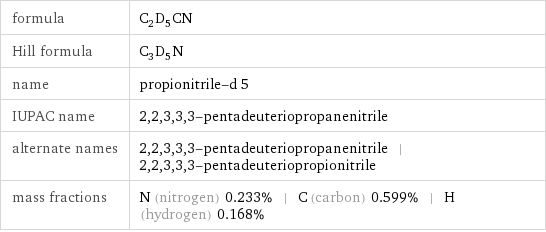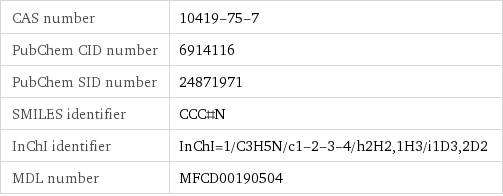Input interpretation

propionitrile-d 5
Chemical names and formulas

formula | C_2D_5CN Hill formula | C_3D_5N name | propionitrile-d 5 IUPAC name | 2, 2, 3, 3, 3-pentadeuteriopropanenitrile alternate names | 2, 2, 3, 3, 3-pentadeuteriopropanenitrile | 2, 2, 3, 3, 3-pentadeuteriopropionitrile mass fractions | N (nitrogen) 0.233% | C (carbon) 0.599% | H (hydrogen) 0.168%
Lewis structure

Draw the Lewis structure of propionitrile-d 5. Start by drawing the overall structure of the molecule, ignoring potential double and triple bonds: Count the total valence electrons of the carbon (n_C, val = 4), hydrogen (n_H, val = 1), and nitrogen (n_N, val = 5) atoms: 3 n_C, val + 5 n_H, val + n_N, val = 22 Calculate the number of electrons needed to completely fill the valence shells for carbon (n_C, full = 8), hydrogen (n_H, full = 2), and nitrogen (n_N, full = 8): 3 n_C, full + 5 n_H, full + n_N, full = 42 Subtracting these two numbers shows that 42 - 22 = 20 bonding electrons are needed. Each bond has two electrons, so in addition to the 8 bonds already present in the diagram add 2 bonds. To minimize formal charge nitrogen wants 3 bonds and carbon wants 4 bonds. Identify the atoms that want additional bonds and the number of electrons remaining on each atom: Fill in the 2 bonds by pairing electrons between adjacent highlighted atoms: Answer: | |
3D structure

3D structure
Basic properties

molar mass | 60.111 g/mol phase | liquid (at STP) melting point | -93 °C boiling point | 97 °C density | 0.842 g/cm^3
Units

Liquid properties (at STP)

density | 0.842 g/cm^3
Units

Non-standard atom properties

H-2 | 5
Chemical identifiers

CAS number | 10419-75-7 PubChem CID number | 6914116 PubChem SID number | 24871971 SMILES identifier | CCC#N InChI identifier | InChI=1/C3H5N/c1-2-3-4/h2H2, 1H3/i1D3, 2D2 MDL number | MFCD00190504
Safety properties

flash point | 6.111 °C